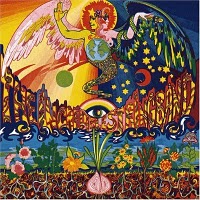 Yes, I think this is even better than The Hangman’s Beautiful Daughter. The difference is while that record gets its strength from its total weirdness — it meanders in the best sense — this one has actual songs: great, great songs that will move you, make you laugh and make you think. “First Girl I Loved” alone is enough to get you seeking out this record, but add to that the prescient sarcasm of “Back In The 1960s” (which foresees the death of the hippie ideal before it had even begun), the Wind In The Willows on acid of “Little Cloud” and “The Hedgehog Song” (The Archbishop of Canterbury’s fave ISB number!) and the simply beautiful “Painting Box”. Plus I love the way Williamson sings. For those of you who wonder what “The Fool On The Hill” would have been liked if Lennon had written it. –Brad
Yes, I think this is even better than The Hangman’s Beautiful Daughter. The difference is while that record gets its strength from its total weirdness — it meanders in the best sense — this one has actual songs: great, great songs that will move you, make you laugh and make you think. “First Girl I Loved” alone is enough to get you seeking out this record, but add to that the prescient sarcasm of “Back In The 1960s” (which foresees the death of the hippie ideal before it had even begun), the Wind In The Willows on acid of “Little Cloud” and “The Hedgehog Song” (The Archbishop of Canterbury’s fave ISB number!) and the simply beautiful “Painting Box”. Plus I love the way Williamson sings. For those of you who wonder what “The Fool On The Hill” would have been liked if Lennon had written it. –Brad
Folk
Fairport Convention “Unhalfbricking” (1969)
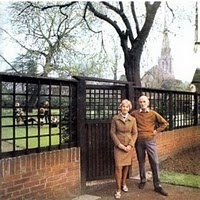 While Liege And Lief may very well be a more revolutionary and influential album than Unhalfbricking, I’m sure I’m not alone in thinking the latter even better than the former. As both their last album as “England’s Answer To Jefferson Airplane” and their first to move decisively towards traditional folk (and to feature Dave Swarbrick), it straddles both camps effortlessly. Of course both Richard Thompson and Sandy Denny contribute two excellent songs each, of which my favourite has always been the jazzy “Autopsy” (what a wonderful drummer Martin Lamble was!). Of course, “Who Knows Where The Time Goes” isn’t exactly a throwaway either. There’s no less than three Bob Dylan tracks, all of them unreleased by Bob in 1969, including the very moving “Percy’s Song”, featuring ex-Fairporter Ian Matthews on harmony vocals. (While this song had been recorded while he was still in the band, it began a tradition of ex-members making cameo appearances on new Fairport records that has made them see less like a band and more like a family.) The stunner, though, has to be the wonderful performance of the traditional song “A Sailor’s Life”, reputedly recorded in one take. I’ll take this one over all of Liege And Lief, thanks. Unlike some of Fairport’s other records, this one hasn’t aged a bit, and there’s absolutely no filler tracks. –Brad
While Liege And Lief may very well be a more revolutionary and influential album than Unhalfbricking, I’m sure I’m not alone in thinking the latter even better than the former. As both their last album as “England’s Answer To Jefferson Airplane” and their first to move decisively towards traditional folk (and to feature Dave Swarbrick), it straddles both camps effortlessly. Of course both Richard Thompson and Sandy Denny contribute two excellent songs each, of which my favourite has always been the jazzy “Autopsy” (what a wonderful drummer Martin Lamble was!). Of course, “Who Knows Where The Time Goes” isn’t exactly a throwaway either. There’s no less than three Bob Dylan tracks, all of them unreleased by Bob in 1969, including the very moving “Percy’s Song”, featuring ex-Fairporter Ian Matthews on harmony vocals. (While this song had been recorded while he was still in the band, it began a tradition of ex-members making cameo appearances on new Fairport records that has made them see less like a band and more like a family.) The stunner, though, has to be the wonderful performance of the traditional song “A Sailor’s Life”, reputedly recorded in one take. I’ll take this one over all of Liege And Lief, thanks. Unlike some of Fairport’s other records, this one hasn’t aged a bit, and there’s absolutely no filler tracks. –Brad
Townes Van Zandt “Townes Van Zandt” (1969)
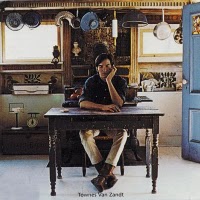 More than any other of Van Zandt’s albums this reflects how unhappy the man must have been with his debut “For The Sake Of The Song.” No less than four of the tracks on here first appeared on that earlier work and, without exception, all are better for the reworking. The lovely Spanish guitar refrains of “For The Sake Of The Song” and “(Quicksilver Daydreams Of) Maria” bring out the best in the plaintive, lovelorn lyrics. “I’ll Be Here In The Morning” is reborn as a tale of a lonesome cowboy heading back home to his true love and “Waiting Around To Die” simply stands as one of Van Zandt’s finest songs. In fact I can give this no more praise than it bears comparison with Dylan’s early folk albums – because, have no doubts, this is a folk album not a country album. And a very sparse one at that. The fact there is so much emotion and feeling on display is down to the voice and the words rather than the music. For instance I have no idea what “Lungs” is really about but it is poetically intense in its imagery and compelling in its tale of loneliness and failure. Equally the depiction of nature as an extension of the human condition in the likes of “Columbine” is both moving and powerful.
More than any other of Van Zandt’s albums this reflects how unhappy the man must have been with his debut “For The Sake Of The Song.” No less than four of the tracks on here first appeared on that earlier work and, without exception, all are better for the reworking. The lovely Spanish guitar refrains of “For The Sake Of The Song” and “(Quicksilver Daydreams Of) Maria” bring out the best in the plaintive, lovelorn lyrics. “I’ll Be Here In The Morning” is reborn as a tale of a lonesome cowboy heading back home to his true love and “Waiting Around To Die” simply stands as one of Van Zandt’s finest songs. In fact I can give this no more praise than it bears comparison with Dylan’s early folk albums – because, have no doubts, this is a folk album not a country album. And a very sparse one at that. The fact there is so much emotion and feeling on display is down to the voice and the words rather than the music. For instance I have no idea what “Lungs” is really about but it is poetically intense in its imagery and compelling in its tale of loneliness and failure. Equally the depiction of nature as an extension of the human condition in the likes of “Columbine” is both moving and powerful.
After listening to a number of Van Zandt’s albums, I’ve come to realise that sometimes the word underrated –although hackneyed and simplistic – is appropriate. To a certain degree, the word undiscovered is also extremely apt in this case because there are a great deal of revered singer-songwriters performing in the same field who don’t come anywhere close to having the sheer emotive power and impact of Van Zandt. He deserves all the plaudits thrown in his direction and I will definitely continue to mine his back catalogue. –Ian
Judee Sill “Heart Food” (1973)
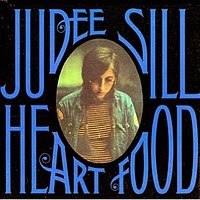 I’ve heard Joni Mitchell, and I’ve heard Laura Nyro, and without wanting to denigrate either of those fine artists, I think Judee Sill’s better than either of them. Actually, that’s not quite fair; Sill reminds me more of Brian Wilson and his “teenage symphonies to God” than either Mitchell or Nyro. Like Wilson, there’s a sense of childlike wonder to Judee; like Wilson, both talk a lot about God (and, in Sill’s case, Jesus) without being explicitly Christian; instead God is used as a name for the Other, the Muse. And, like Wilson, Sill fuses all sorts of musics — pop, soul, doo-wop, folk, “cosmic cowboy music” similar to Gene Clark’s — with an elaborate sense of orchestration to come up with something completely open, gorgeously sunny, wistfully dark and totally sensuous. In his liner notes to the CD reissue, XTC’s Andy Partridge talks about the “velvet milk” of this record, and that’s a perfect description of its plushness (but not lushness). Anyone who could hear “The Donor” and not acclaim its composer as a pop genius doesn’t deserve a record player. You can, charitably, see why it didn’t sell in 1973: just too damn individual and demanding a listen. Then again, Pet Sounds didn’t sell either. –Brad
I’ve heard Joni Mitchell, and I’ve heard Laura Nyro, and without wanting to denigrate either of those fine artists, I think Judee Sill’s better than either of them. Actually, that’s not quite fair; Sill reminds me more of Brian Wilson and his “teenage symphonies to God” than either Mitchell or Nyro. Like Wilson, there’s a sense of childlike wonder to Judee; like Wilson, both talk a lot about God (and, in Sill’s case, Jesus) without being explicitly Christian; instead God is used as a name for the Other, the Muse. And, like Wilson, Sill fuses all sorts of musics — pop, soul, doo-wop, folk, “cosmic cowboy music” similar to Gene Clark’s — with an elaborate sense of orchestration to come up with something completely open, gorgeously sunny, wistfully dark and totally sensuous. In his liner notes to the CD reissue, XTC’s Andy Partridge talks about the “velvet milk” of this record, and that’s a perfect description of its plushness (but not lushness). Anyone who could hear “The Donor” and not acclaim its composer as a pop genius doesn’t deserve a record player. You can, charitably, see why it didn’t sell in 1973: just too damn individual and demanding a listen. Then again, Pet Sounds didn’t sell either. –Brad
Richard Thompson “Henry the Human Fly” (1972)
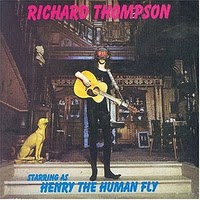 Richard Thompson’s solo debut is, not surprisingly, the one where the chilly folk rock wind of his former band blows most freely, a creaky, moldy affair that matches his stuffy-nosed vocals to a set of weary and ominous songs. The traditional, old world atmosphere of Henry perfectly suits tracks like the fearsome “Roll Over Vaughn Williams,” sorrowful folk ballad “The Poor Ditching Boy,” and drunken “Twisted,” yet also limits the immediate appeal of the album. Elsewhere there’s “The Old Changing Way,” a simple and affecting tale of fragmented brotherhood, while the clouds briefly part with the arrival of Sandy Denny and Linda Peter’s (soon Linda Thompson) vocals on the virtually upbeat “The Angels Took My Racehorse Away,” never mind it’s sentiment of loss. While it’s hard to recommend the soggy sounds of Henry to those who’ve yet to be converted to the doom and gloom of Thompson’s world, it’s also not hard to see why, with it’s distilled purity, it’s become an unlikely favorite. –Ben
Richard Thompson’s solo debut is, not surprisingly, the one where the chilly folk rock wind of his former band blows most freely, a creaky, moldy affair that matches his stuffy-nosed vocals to a set of weary and ominous songs. The traditional, old world atmosphere of Henry perfectly suits tracks like the fearsome “Roll Over Vaughn Williams,” sorrowful folk ballad “The Poor Ditching Boy,” and drunken “Twisted,” yet also limits the immediate appeal of the album. Elsewhere there’s “The Old Changing Way,” a simple and affecting tale of fragmented brotherhood, while the clouds briefly part with the arrival of Sandy Denny and Linda Peter’s (soon Linda Thompson) vocals on the virtually upbeat “The Angels Took My Racehorse Away,” never mind it’s sentiment of loss. While it’s hard to recommend the soggy sounds of Henry to those who’ve yet to be converted to the doom and gloom of Thompson’s world, it’s also not hard to see why, with it’s distilled purity, it’s become an unlikely favorite. –Ben
Incredible String Band “The Hangman’s Beautiful Daughter” (1968)
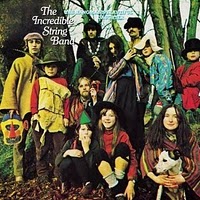 The Hangman’s Beautiful Daughter. Where to start? The lyrics are full of imagination, but almost devoid of sense. In that respect, this is almost the ultimate psychedelic album. Though Heron and Williamson lack the lyricism of Dylan, they come up with some nice music. “Koeeoaddi There” starts the album in classic psychedelic style. There aren’t two related sentences there. Sometimes there aren’t even two related clauses within a sentence. It all becomes too much when Williamson sings ‘Ladybird, ladybird, what is your wish? Your wish is not granted unless it’s a fish’. This is followed by the equally weird “The Minotaur’s Song” which is sung in the style of a Gilbert and Sullivan operetta. The classic line this time: ‘I can’t dream well because of my horns’. The best song is “A Very Cellular Song”. Even this is best appreciated with an unnaturally open mind. It starts off in sort of hazy fairground style, then breaks into a touching spiritual. This is followed by what I can best describe as spoof-baroque. Next is some kind of folk interlude, before the spoof-baroque resumes. The music then takes the back seat as some strange lyrics about slithering and squelching take the foreground. The final section sees a return to fairground music accompanying some mystical mantra or something. Remarkable, but totally bizarre. –Jim
The Hangman’s Beautiful Daughter. Where to start? The lyrics are full of imagination, but almost devoid of sense. In that respect, this is almost the ultimate psychedelic album. Though Heron and Williamson lack the lyricism of Dylan, they come up with some nice music. “Koeeoaddi There” starts the album in classic psychedelic style. There aren’t two related sentences there. Sometimes there aren’t even two related clauses within a sentence. It all becomes too much when Williamson sings ‘Ladybird, ladybird, what is your wish? Your wish is not granted unless it’s a fish’. This is followed by the equally weird “The Minotaur’s Song” which is sung in the style of a Gilbert and Sullivan operetta. The classic line this time: ‘I can’t dream well because of my horns’. The best song is “A Very Cellular Song”. Even this is best appreciated with an unnaturally open mind. It starts off in sort of hazy fairground style, then breaks into a touching spiritual. This is followed by what I can best describe as spoof-baroque. Next is some kind of folk interlude, before the spoof-baroque resumes. The music then takes the back seat as some strange lyrics about slithering and squelching take the foreground. The final section sees a return to fairground music accompanying some mystical mantra or something. Remarkable, but totally bizarre. –Jim
Tiny Tim “God Bless Tiny Tim” (1968)
 A walking freak show and the ultimate novelty act of the ’60s. But behind Tiny Tim’s fruity falsetto antics lay a genuine love of his material, most of it taken from the 20’s – an equally odd time in popular music–before the rise of Bing Crosby–when nearly all white male vocalists were no-voice freaks. I can’t honestly say that Tim’s debut LP survives its own novelty value in the end. But it’s a well-produced smorgasbord of highly entertaining moments complete with genuine hilarity (“The Viper”) and some genuinely touching performances as well, especially the ones done in the singer’s natural baritone (Gordon Jenkins’ “This Is All I Ask,” “Then I’d Be Satisfied with Life.”) Another curiosity: why was this kind of faux-vaudeville so popular in the ’60s? Does anybody remember “Winchester Cathedral”? In that sense Tiny Tim fit right into his times. During the late ’50s and early ’60s when he performed at Hubert’s Museum (singing Don Gibson’s “Oh Lonesome Me” underwater) and appeared in Jack Smith’s Normal Love, he was merely freakish. –Singer Saints
A walking freak show and the ultimate novelty act of the ’60s. But behind Tiny Tim’s fruity falsetto antics lay a genuine love of his material, most of it taken from the 20’s – an equally odd time in popular music–before the rise of Bing Crosby–when nearly all white male vocalists were no-voice freaks. I can’t honestly say that Tim’s debut LP survives its own novelty value in the end. But it’s a well-produced smorgasbord of highly entertaining moments complete with genuine hilarity (“The Viper”) and some genuinely touching performances as well, especially the ones done in the singer’s natural baritone (Gordon Jenkins’ “This Is All I Ask,” “Then I’d Be Satisfied with Life.”) Another curiosity: why was this kind of faux-vaudeville so popular in the ’60s? Does anybody remember “Winchester Cathedral”? In that sense Tiny Tim fit right into his times. During the late ’50s and early ’60s when he performed at Hubert’s Museum (singing Don Gibson’s “Oh Lonesome Me” underwater) and appeared in Jack Smith’s Normal Love, he was merely freakish. –Singer Saints
Richard & Linda Thompson “I Want to See the Bright Lights Tonight” (1974)
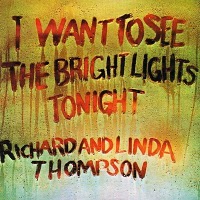 Thompson’s second album, and first With wife Linda on board as a lead vocalist, I Want to See the Bright Lights Tonight, more than any, goes a long way toward establishing his reputation as a gloom-merchant. And man, with heavy ballads like “Withered And Died,” “Has He Got A Friend For Me,” “The End Of The Rainbow,” and the stark “The Great Valerio,” the floor here is certainly littered with crushed dreams, sealed fates, abandonment, and all around misery. Even the uptempo tracks like “When I Get to the Border” and “I Want to See the Bright Lights Tonight” are fueled by a weary desperation, Thompson’s biting electric guitar sounding more like frayed nerves than any sort of celebratory riffing. In fact, the album would probably be near-unbearable if the performances weren’t so beautiful, the songs so well written, and the atmosphere so unusually compelling, Linda Thompson’s voice in particular being incredibly well suited to the material. But yeah, your ultimate acceptance of this album will probably rest on how much despair you can handle in one sitting, but given a chance to work it’s way into you, I Want to See the Bright Lights Tonight won’t let go. -Ben
Thompson’s second album, and first With wife Linda on board as a lead vocalist, I Want to See the Bright Lights Tonight, more than any, goes a long way toward establishing his reputation as a gloom-merchant. And man, with heavy ballads like “Withered And Died,” “Has He Got A Friend For Me,” “The End Of The Rainbow,” and the stark “The Great Valerio,” the floor here is certainly littered with crushed dreams, sealed fates, abandonment, and all around misery. Even the uptempo tracks like “When I Get to the Border” and “I Want to See the Bright Lights Tonight” are fueled by a weary desperation, Thompson’s biting electric guitar sounding more like frayed nerves than any sort of celebratory riffing. In fact, the album would probably be near-unbearable if the performances weren’t so beautiful, the songs so well written, and the atmosphere so unusually compelling, Linda Thompson’s voice in particular being incredibly well suited to the material. But yeah, your ultimate acceptance of this album will probably rest on how much despair you can handle in one sitting, but given a chance to work it’s way into you, I Want to See the Bright Lights Tonight won’t let go. -Ben


